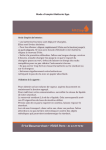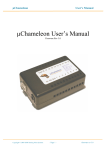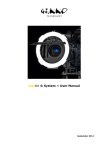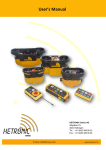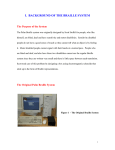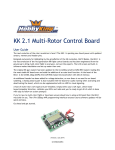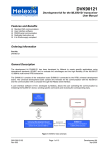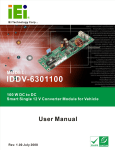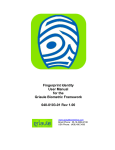Download EGO Biometric Sensor User Manual
Transcript
Biometric access system EGO UBR MODULE Installers manual -1- Table of contents Safety information................................................................................................................................... 2 Precautions .............................................................................................................................................. 2 Features ................................................................................................................................................... 3 Definition of terms .................................................................................................................................. 3 Basic operation and use........................................................................................................................... 4 EGO UBR Module Overview ................................................................................................................. 6 Installation and connection...................................................................................................................... 8 Mechanical Drawings............................................................................................................................ 11 Troubleshooting .................................................................................................................................... 13 Servicing................................................................................................................................................ 14 Appendix 1 - Abbreviations .................................................................................................................. 15 Safety information If the module suffers any kind of damage • Turn off the power and unplug the unit’s power supply from the wall outlet immediately if the module begins to make any unusual noises or gives off smoke or an unusual smell. Then call EGO Secure Systems Ltd for service. Moisture and liquid entry • To prevent the risk of electric shock or damage to the internal electronics of the module switch off the module and contact EGO Secure Systems Ltd for service. Foreign object entry • Never insert or drop any metallic or inflammable objects into any of the openings on this module, as this may cause fire, electric shock or electrical failure. Fire prevention • To prevent fire, never place any type of candle or naked flame on or near the UBR module. Precautions Excessive shock • Due to the sensitive nature of biometric devices they must always be handled with care. Excessive force or sharp knocks may damage the precision parts inside the unit resulting in poor quality of operation. Servicing • To reduce risk of electric shock, do not attempt to remove the protective covers or panels that house the module. There are no user serviceable parts within the module. If service is required, contact EGO Secure Systems Ltd. -2- Features Finger vein biometric authentication • • • • • • Identification based on internal finger vein patterns Very high level of authentication Module hold up to 1000 templates Suitable for the visually impaired Ethernet connection for remote control by as ‘Intelligent’ server Internal automated control (stand-alone) modes Definition of terms Biometric Biometric refers to the process of uniquely identifying an individual through the measurement of some aspect of their anatomy. In the case of the EGO UBR Module, it is the measurement of the unique vein patterns inside a person’s finger that are used to identify an individual. Template A Template is a unique set of numbers representing the pattern of veins in a person finger. The EGO Module can create Templates using the registration process. Please note that the EGO UBR Module allows each user to have up to twenty stored templates. The maximum number of templates that the EGO UBR Module can hold is 1000. Registration Registration is the process of the scanning of a user’s finger to obtain a biometric template. Authentication Authentication is the process in which the user’s finger (placed on the scanner) is compared to one or more biometric templates. The EGO UBR Module supports 2 forms of Authentication; authentication against the biometric templates stored within the EGO UBR Module’s internal template database or authentication against one or more (up to 20) external templates. Intelligent Server The Intelligent server is a machine which exists on the same network as the EGO UBR Module and issues commands to the EGO UBR Module using the network. Time and attendance logging Time and attendance logging is the recording of users and the times in which they enter and exit the controlled door. -3- Secure and un-secure sides of a door The un-secure side of a door is the side open to the public or anyone that is not registered. The secured side is the side of the door in which the EGO UBR Module is designed to protect or restrict access. Identify Mode The Identity Mode is a special function used to indentify a module connected to the Ethernet. It has nothing to do with indentifying, verifying or authenticating a user. In ‘Identify Mode’ the specific EGO module selected in the software is commanded to flash the Multipurpose Indicator Light in an unusual colour sequence and to beep the sounder approximately every 9 seconds. This enables an installer to verify which NetBios name relates to which physical module. Basic operation and use An extract from the Hitachi VeinID Website Based on the unique patterns of veins, vascular pattern recognition (VPR), or vein pattern recognition, provides the ease of use of hand geometry with much improved accuracy, smaller readers and a much more hygienic approach. It uses near-infrared light generated from a bank of Light Emitting Diodes projected through an individual’s skin to enable a high-contrast matching of vein patterns (e.g., vein branching points, vein thickness, and branching angles). VPR systems scan the de-oxygenated veins, extract key pattern features via contactless, nearinfrared optical sensor systems, digitize the extracted pattern recognition, and then match the transaction templates to the respective pre-established enrollment template. By measuring the veins under the skin, it is very difficult for unauthorized persons to observe or capture this pattern, rendering VPR a highly secure method of identity verification. Since 1997 Hitachi has been developing an original biometric, finger vein authentication technology, which uses the finger vein pattern obtained from passing light through a finger as a key. Its first commercial systems were deployed in 2004. -4- As illustrated in the adjacent figure, near-infrared light generated by a bank of light emitting diodes penetrates the body tissue; it is reflected in the hemoglobin in the blood. A CCD camera (which uses a small, rectangular piece of silicon to receive incoming light) captures the image of the vein pattern through this reflected light. Image processing constructs a finger vein pattern from the camera image. This pattern is compressed and digitized so that it can be registered as a template for biometric authentication. Within a split second, the FV system filters the digitized image, produces a template or digitized image that it compares to the stored template of the user, and determines whether there is a match, using pattern-matching techniques. Variations in environmental temperature or a person’s blood pressure can sometimes cause fluctuations in the width and brightness of the blood vessels. The Hitachi finger vein system pinpoints the position of the center of each blood vessel so that those vein fluctuations do not affect the matching procedure. For repeatable and good quality registration and authentication the positioning of the finger in the biometric scanner is very important. Figure 1 shows the first finger in the biometric scanner with the tip of the finger in to top guide and the base of the finger fitted into the bottom guide. The finger should be held straight and still for the period of the registration or authentication process (this may be up to six seconds). The finger should not be tensioned too much during registration as this may be difficult to replicate during subsequent authentications. Figure 1 Correct positioning of the finger The EGO UBR Module has been designed so that any finger may be used for authentication and registration. Some users may find it more comfortable to use the middle finger as shown in figure 2. -5- Note that up to 20 templates may be stored in the EGO UBR Module associated with a single user. This is useful in that a slight rotation of the finger between registrations (The finger must be held still for the period of the registration) will speed up the authentication process. The down side to this is a reduction in the number of different users that may be stored in the EGO UBR Module due to the 1,000 template limit. Figure 2 Use of middle finger for registration and authentication A way around the 1,000 user limit (1 template per user) is to preselect the templates using a card or pin number and then download only those templates require for authentication. Alternatively using an EGO UBR Module with smart card reader fitted internally a template may be read from the card and a match made using that template. EGO UBR Module Overview The EGO UBR Module (with the biometric sensor fitted) is mounted on the un-secured side of the door and is designed to permit users entry through the door via a biometric finger match. If a finger match is successful the door will unlock for a programmable period of time allowing access. -6- Multipurpose indicator light Biometric scanner indicator light Biometric scanner There are 2 distinct feedback light emitting diodes on the EGO UBR Module; the Multipurpose Indicator Light and the Biometric Scanner Indicator Light mounted on the HOTS VeinID module itself. The Biometric Scanner Indicator light is almost exclusively controlled by the HOTS VeinID module; however there is a command which can be issued by an Intelligent Server to cause the Biometric Scanner Indicator light to glow green. The Multipurpose indicator light is under the control of the EGO Module processor and may be commanded by an Intelligent Server to show various colours, or controlled using the ‘Green LED’ and ‘Red LED’ connections (Stand Alone mode only). This Multipurpose Indicator Light may also be controlled by a door controller and connections are provided. The information displayed by both the Multipurpose Indicator Light and the Biometric Scanner Indicator Light is detailed below: - Multipurpose Indicator Light Glowing Green External software has signalled that all is correct (and for example the door has been unlocked). Glowing Red External software has rejected identification (and for example the door has stayed locked). Cycling through primary colours The EGO Module is in Identify mode (buzzer will intermittently sound as well) -7- Glowing Yellow The EGO Module is in resetting (booting or forced reset) Blue flash (every nine seconds) The EGO Module is in stand-bye mode waiting a network connection. Note that is usual for the EGO Module feedback LED to be turned off while the Hitachi VeinID module LED is providing feedback to minimise confusion in the user. Biometric Scanner Indicator Light Glowing green The Biometric Scanner’s start-up procedure has been completed. The light should automatically turn off after a few seconds. Note that even when the Biometric Scanner indicates that it has completed its start-up procedure, the EGO UBR Module may still have additional tasks to perform before the entire start-up procedure is complete. There is also a command which allows an intelligent server to cause the light to glow green. Flashing blue Finger vein registration or authentication is in progress. Glowing blue Finger vein registration or verification has been successfully completed. Flashing red Finger vein registration or verification has failed. Glowing red Hitachi VeinID error status; an error in the operation of the device has occurred or the unit has detected inadequate light levels for operation. Installation and connection Operating conditions • • • • • • • • • • • 802.3af - 2003 compliant Power over Internet 13 watt supply Auxiliary 12V dc +/- 8% input at 1 Amp supplied by Regulated 12 volt supply at 1.25 amps Operating and Storage Temperature -10°C to +75°C 15% to 85% Relative Humidity (Non-Condensing) -10°C to 60°C (ambient temperature) Hitachi VeinID Module operating 5°C to 45°C Fully CE approved and tested RoHS Compliant May be used outdoors with addition of an EGO Weather Cowl No direct sunlight Limited light sources to 2,300 lux or less Recommended light: Fluorescent lamp (Light intensity centred around a wavelength of 500~600nm) Recommended colour: -8- White, daylight white, daylight colour Cable lengths The EGO Biometric Module, as with all EGO Modules, has been designed to use Cat5E screened cable with a screened RJ45 connector providing an earth to the module. If a fully screened RJ45 connector is not used and to comply with the CE specification there is a 3mm screw earth point provided on the metal chassis of the EGO module and this should be connected to a good earth point. The lengths of cables that may be used to connect the EGO Module to the rest of the system are limited by the use of the EGO Module. When the EGO Module is powered using the Power over Ethernet function then the cable length between the EGO Module and the Power over Ethernet injector is a maximum of 90 metres. When a legacy mode is used and the power is applied via the Wiegand cables then the maximum cable length can be as little as 25 metres. DC supply Note that using an external DC supply the voltage applied to the EGO Biometric Sensor module should be +12 volts DC +/-8%. This is for the Hitachi UBR module. The module will draw approximately 600mA (after inrush current). It is recommended that a 12 volt regulated power supply is used. Care must be taken if the power cables are long as there may be significant voltage drop however the voltage applied to the EGO Biometric Sensor Module must never exceed 12.9volts DC or drop below 11.1volts. Out door use While the EGO Module is designed to be weather proof to IP67 the Hitachi VeinID module is not. Also the Hitachi VeinID module will not work in bright daylight. To overcome these limitations RFID Systems PLC can supply a weatherproof hood that allows external use in all but the most extreme conditions. NB the Hitachi VeinID Module performs a self-diagnosis soon after power is applied. If the lighting environment is inappropriate, the Hitachi VeinID feedback LED will glow red. Recommended light: Fluorescent lamp (Light intensity centred on a wavelength of 500~600nm) Recommended colour: White, daylight white, daylight colour Power over Ethernet The EGO Module (like most EGO modules) supports both Mode A and Mode B Power over Ethernet to IEEE std.802.3af-2003. This means that any POE injector, both mid span and end span may be used to power the EGO module. POE Description: 36v to 57v (nominally 48v), applied to the Ethernet twisted pairs pins 1-2 and 3-6 (mode A) or to pins 4-5 and 7-8 (Mode B), is tapped off from the Ethernet magnetic’s and applied via two bridge rectifiers to the POE conditioning circuits. These POE conditioning circuits apply the correct loads, in sequence, to set the correct ‘power class’ (in this case 13 watts) for the EGO Biometric Sensor Module. Further circuits within the EGO module then condition the DC supplies required for the Hitachi VeinID module and the rest of the circuits. -9- Note that the End Span POE source will supply many Ethernet POE units and is often called a POE Switch, as the functions of an Ethernet Switch and POE source are combined into one unit; while a Mid Span unit is called an Ethernet Injector, as it usually only supplies one unit. Connections Signal Ground Wiegand Data 0 JP2 Wiegand Data 1 Ethernet Cable 1 Green LED Red LED JP1 1 Buzzer RJ45 Ethernet Connector +'ve DC Supply JP6 +'ve DC Supply 1 -'ve DC Supply LED A LEDB Yellow Red Note that the Signal ground connection and the –‘ve DC Supply connection are linked together inside the EGO Module. Also on JP6 the two +’ve DC Supply connections are linked inside the EGO Module. - 10 - To illuminate the Red or Green Multipurpose Indicator Light or to sound the Buzzer (in standalone mode only) the relevant pin on JP1 should be pulled to ground, with for example an open collector transistor. These 3 pins are pulled up to 3v3 DC inside the EGO Biometric Sensor module via a 4k7 resistors. The two LEDs labelled as LED A and LED B on the connection diagram are configured to automatically display link status (Yellow) and RX/TX activity (Red) of the EGO UBR Module Ethernet port. Legacy Support The EGO UBR Module can support Legacy door controllers and other devices by using the Wiegand data output option. The Wiegand bus consists of two data lines and a signal return line. The data lines sit at a positive voltage, in the case of the EGO Module this is + 5volts DC with respect to the signal ground pin. Data is transmitted by setting either the 0 line or the 1 line to ground for a short period. There is no valid condition (with power applied to the unit) where both the Data 0 line and the Data 1 line can be at zero volts at the same time. Note that the Wiegand Data 0 and Data 1 lines will not supply a significant amount of current and should not be used as power sources for other circuitry. The Wiegand bus may be formatted for almost any data length and information content but will be shipped with the 26 bit format as shown below. Wiegand 26 bit format as follows: PSSSSSSSSNNNNNNNNNNNNNNNNP BIT 1 2 9 10 25 26 where BIT 1 is an even parity for the following 12 bits. The sum of bits 1-13 is even. BITS 2-9 are the SITE CODE. BITS 10-25 are the USER CODE. BIT 26 is an odd parity over the previous 12 bits. The sum of bits 14-26 is odd. Mechanical Drawings This section shows the mechanical drawings for mounting an EGO Module onto a wall. The Drawing below gives dimensions of the 4 fixing holes (note that the drawing is 1 to 1 scale and may be used as a drilling template). There are 5 areas in the EGO wall mounting plate that are - 11 - designed to allow cable access; 1 central gland molding in the centre of the base and 4 areas around the side walls. There are corresponding areas on the EGO Cover. The Wall plate is mounted on the wall first and the cabling made ready. The connections are then made to the EGO module. The EGO Module is fitted to the wall plate at the top first and - 12 - then a single screw is used to fix it to the bottom. The screw hole is covered by the EGO Label supplied with the module once all the connections have been proved. Troubleshooting If the EGO UBR Module fails to operate normally, please check the following points to determine whether the fault can be corrected by the simple measures suggested. If it cannot be corrected or the fault is not listed in the SYMPTOM column, please contact EGO Secure Systems Ltd. Symptom Remedy - 13 - No power. Check that the power is switched on and the supply lead is connected to the correct connections (JP5). If using POE please check the POE transformer or supply; ensure the Ethernet Leads are securely fitted and not damaged EGO UBR module appears to be dead. Check that all connections are in their correct locations and all the connectors are fitted securely. EGO UBR module is making a loud alarm sound. The module’s tamper alert may have been triggered. Turn off the alarm using the reset-alarm option in the API. If the tamper was in fact tripped, check module for damage The alarm will sound again if either tamper sensor is still active; cycling the power will not reset the tamper. This can be due to a variety of factors especially the position of the finger. The finger must be in exactly the same position as it was registered in, some users will register the same finger a number of times in slightly different positions to overcome this. Other factors that may prevent successful identification are fingers that are dirty, cold, and very dry, also those who suffer from some skin complaints. Please read the above remedy regards difficulty in authenticating a finger. One other factor that needs to be noted is that the finger that is being registered must be in the correct position and remain still throughout the process, failing to do this will cause a registration failure. Most common cause for this is bad lighting levels. The unit has difficulty authenticating a finger in scan mode. The unit seems to have difficulty in registering my finger. The EGO UBR module’s biometric sensor light is a solid red. The device performs a self-diagnosis while powered on. If the lighting environment is inappropriate, the device status LED will glow red. Take appropriate measures if the device does not work properly due to environmental factors such as direct sunlight. If the device is placed in unacceptable lighting like direct sunlight or foreign objects such as garbage are left on the device when the power supply is on, a self diagnosis error will occur and the device status LED will turn red. Do not use the device under such light sources as incandescent lamps (an electronic bulb), mercury lamps, or halogen lamps. The device’s performance will be affected. A weather cowl with built in infra red filters is available from EGO Secure Systems Ltd. Servicing For service and support please contact EGO Secure Systems Ltd. - 14 - Important notice To reduce risk of electric shock, do not attempt to remove the protective covers or panels that house the module. There are no user serviceable parts within the module. Appendix 1 - Abbreviations DHCP……………………………………. Dynamic Host Configuration Protocol FVU……………………………………… Finger Vein Unit IP…………………………………………. Internet Protocol ISSA……………………………………... Intelligent Stand Alone RoHS…………………………………….. Release of Hazard Materials Directive TCP………………………………………. Transmission Control Protocol UBR……………………………………… Universal Biometric Reader - 15 -















